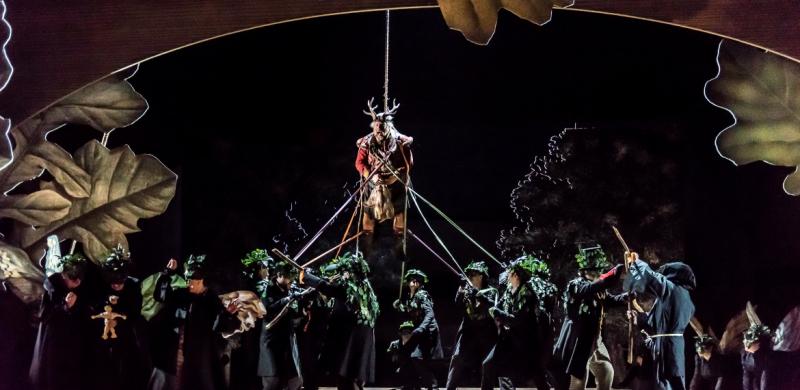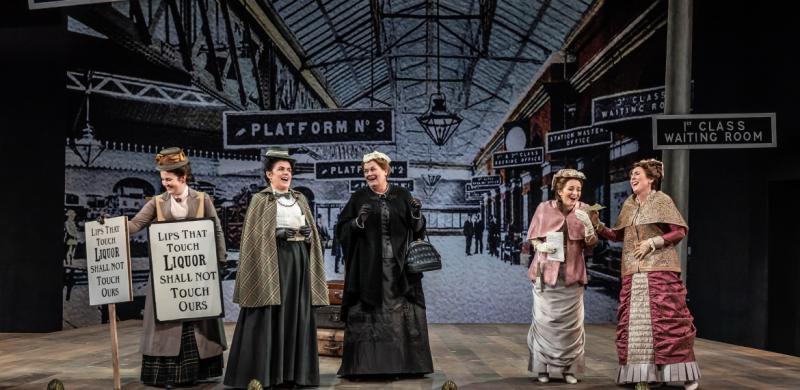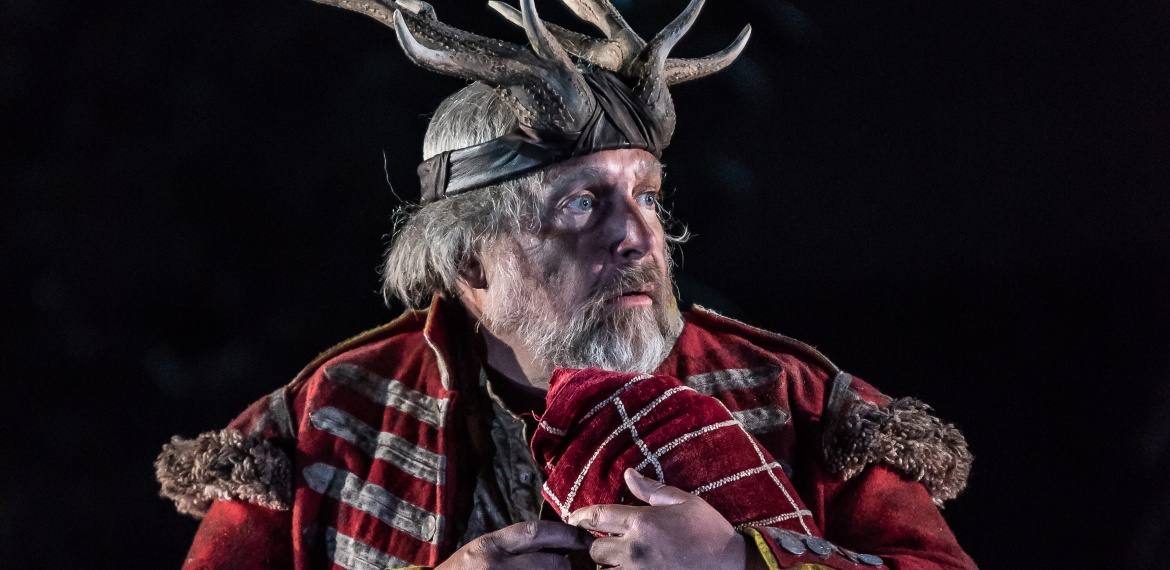Falstaff, Garsington Opera review - Sir John under pressure | reviews, news & interviews
Falstaff, Garsington Opera review - Sir John under pressure
Falstaff, Garsington Opera review - Sir John under pressure
Musically strong, but updating the action has consequences

All those pranks, set-ups, fake letters and disguises, they just keep coming thick and fast in Verdi’s Falstaff. The score has irresistible energy and momentum.
And yet the dreamy setting, the Wormsley estate where Garsington Opera has made its summer home for the past eight years, with its astonishing grounds and gardens, seems to impart an air of unreality, detachment, immateriality. It almost has its way of intruding on the unfolding story. I found my attention drawn by a vast elder bush to the left of the stage outside the opera pavilion, which just stands there and quivers in the summer wind, insouciant to the passions, machinations and frenetic action onstage.
And talking of trees, where were they? It is probably pedantic and over-literal to mention it, but there is a scene where Verdi and librettist Boito specifically ask for them. They even say where on the stage they want them: “in the middle of the stage with Ford’s house to the left”. Garsington’s production directed by Bruno Ravella has not just teleported the action of Falstaff from the reign of (the English) Henry IV into the early 20th century, and the period of the suffragettes. It has transplanted that particular domestic scene (Act 1 Scene 2), and jollied it up by setting it on the concourse of a station, complete with a puffing steam locomotive, which duly received its own round of applause (pictured below, Hollie-Anne Bangham (chorus) Victoria Simmonds, Yvonne Howard, Soraya Mafi, Mary Dunleavy).  What does the updating achieve? The main answer is to reinforce and semaphore the implicit message that it is the women in the story whose will is going to prevail. That’s no bad thing, but Falstaff risks not being just a figure of fun; both the updating and the stage business point a more constant wagging and accusing finger at him. This Falstaff is not just a fantasist, but an abuser of women.
What does the updating achieve? The main answer is to reinforce and semaphore the implicit message that it is the women in the story whose will is going to prevail. That’s no bad thing, but Falstaff risks not being just a figure of fun; both the updating and the stage business point a more constant wagging and accusing finger at him. This Falstaff is not just a fantasist, but an abuser of women.
Bass-baritone Henry Waddington (pictured below) was making his debut in the role. Surrounded by stalwarts of the UK opera scene, formidable character actors such as Yvonne Howard in the role of Mistress Quickly or Adrian Thompson as Bardolfo, I thought he was simply outgunned on this opening night. As Geraint Evans once told a young Bryn Terfel, “presence on the stage has to be something that holds the eye of whoever is spending their hard-earned cash to see you.” For presence also read swagger. Is Henry Waddington capable of that? Yes, and as the run progresses he is bound to put his own stamp on this role more than he did on Saturday.  The other principals were excellent. The crispest enunciation, the best Italian and huge rhythmic positivity was coming from Richard Burkhard in the role of Ford. Mary Dunleavy as Alice and Victoria Simmons as Meg were both well-drawn characters. The young lovers Nanetta and Fenton both shone as performed by Soraya Mafi and Oliver Johnston, and Colin Judson was a highly memorable Dr Caius.
The other principals were excellent. The crispest enunciation, the best Italian and huge rhythmic positivity was coming from Richard Burkhard in the role of Ford. Mary Dunleavy as Alice and Victoria Simmons as Meg were both well-drawn characters. The young lovers Nanetta and Fenton both shone as performed by Soraya Mafi and Oliver Johnston, and Colin Judson was a highly memorable Dr Caius.
Richard Farnes conducted the Philharmonia Orchestra with real clarity and purpose. To my ears there was complete unanimity between stage and pit until one swiftly righted section in Act 3. Given the pace of the piece, that is no mean achievement for an opening night. And the wind principals of the Philharmonia really are a top-flight crew, notably Jill Crowther on cor anglais and, when the horn comes into its own in the final act, Nigel Black. The chorus directed by Susanna Stranders proved what a force for good they are in the final scene. The designs by Giles Cadle and the lighting by Malcolm Rippeth, particularly for the final scene in Windsor Forest, were delightful.
This is a thoroughly professional and well-executed Falstaff. And it has been a fascinating idea to juxtapose it for this thirtieth season at Garsington Opera with two other composers’ last works for the opera stage, Mozart's Die Zauberflöte and Strauss's Capriccio.
rating
Explore topics
Share this article
The future of Arts Journalism
You can stop theartsdesk.com closing!
We urgently need financing to survive. Our fundraising drive has thus far raised £49,000 but we need to reach £100,000 or we will be forced to close. Please contribute here: https://gofund.me/c3f6033d
And if you can forward this information to anyone who might assist, we’d be grateful.

Subscribe to theartsdesk.com
Thank you for continuing to read our work on theartsdesk.com. For unlimited access to every article in its entirety, including our archive of more than 15,000 pieces, we're asking for £5 per month or £40 per year. We feel it's a very good deal, and hope you do too.
To take a subscription now simply click here.
And if you're looking for that extra gift for a friend or family member, why not treat them to a theartsdesk.com gift subscription?
more Opera
 The Railway Children, Glyndebourne review - right train, wrong station
Talent-loaded Mark-Anthony Turnage opera excursion heads down a mistaken track
The Railway Children, Glyndebourne review - right train, wrong station
Talent-loaded Mark-Anthony Turnage opera excursion heads down a mistaken track
 La bohème, Opera North review - still young at 32
Love and separation, ecstasy and heartbreak, in masterfully updated Puccini
La bohème, Opera North review - still young at 32
Love and separation, ecstasy and heartbreak, in masterfully updated Puccini
 Albert Herring, English National Opera review - a great comedy with depths fully realised
Britten’s delight was never made for the Coliseum, but it works on its first outing there
Albert Herring, English National Opera review - a great comedy with depths fully realised
Britten’s delight was never made for the Coliseum, but it works on its first outing there
 Carmen, English National Opera review - not quite dangerous
Hopes for Niamh O’Sullivan only partly fulfilled, though much good singing throughout
Carmen, English National Opera review - not quite dangerous
Hopes for Niamh O’Sullivan only partly fulfilled, though much good singing throughout
 Giustino, Linbury Theatre review - a stylish account of a slight opera
Gods, mortals and monsters do battle in Handel's charming drama
Giustino, Linbury Theatre review - a stylish account of a slight opera
Gods, mortals and monsters do battle in Handel's charming drama
 Susanna, Opera North review - hybrid staging of a Handel oratorio
Dance and signing complement outstanding singing in a story of virtue rewarded
Susanna, Opera North review - hybrid staging of a Handel oratorio
Dance and signing complement outstanding singing in a story of virtue rewarded
 Ariodante, Opéra Garnier, Paris review - a blast of Baroque beauty
A near-perfect night at the opera
Ariodante, Opéra Garnier, Paris review - a blast of Baroque beauty
A near-perfect night at the opera
 Cinderella/La Cenerentola, English National Opera review - the truth behind the tinsel
Appealing performances cut through hyperactive stagecraft
Cinderella/La Cenerentola, English National Opera review - the truth behind the tinsel
Appealing performances cut through hyperactive stagecraft
 Tosca, Royal Opera review - Ailyn Pérez steps in as the most vivid of divas
Jakub Hrůša’s multicoloured Puccini last night found a soprano to match
Tosca, Royal Opera review - Ailyn Pérez steps in as the most vivid of divas
Jakub Hrůša’s multicoloured Puccini last night found a soprano to match
 Tosca, Welsh National Opera review - a great company reduced to brilliance
The old warhorse made special by the basics
Tosca, Welsh National Opera review - a great company reduced to brilliance
The old warhorse made special by the basics
 BBC Proms: The Marriage of Figaro, Glyndebourne Festival review - merriment and menace
Strong Proms transfer for a robust and affecting show
BBC Proms: The Marriage of Figaro, Glyndebourne Festival review - merriment and menace
Strong Proms transfer for a robust and affecting show
 BBC Proms: Suor Angelica, LSO, Pappano review - earthly passion, heavenly grief
A Sister to remember blesses Puccini's convent tragedy
BBC Proms: Suor Angelica, LSO, Pappano review - earthly passion, heavenly grief
A Sister to remember blesses Puccini's convent tragedy

Add comment